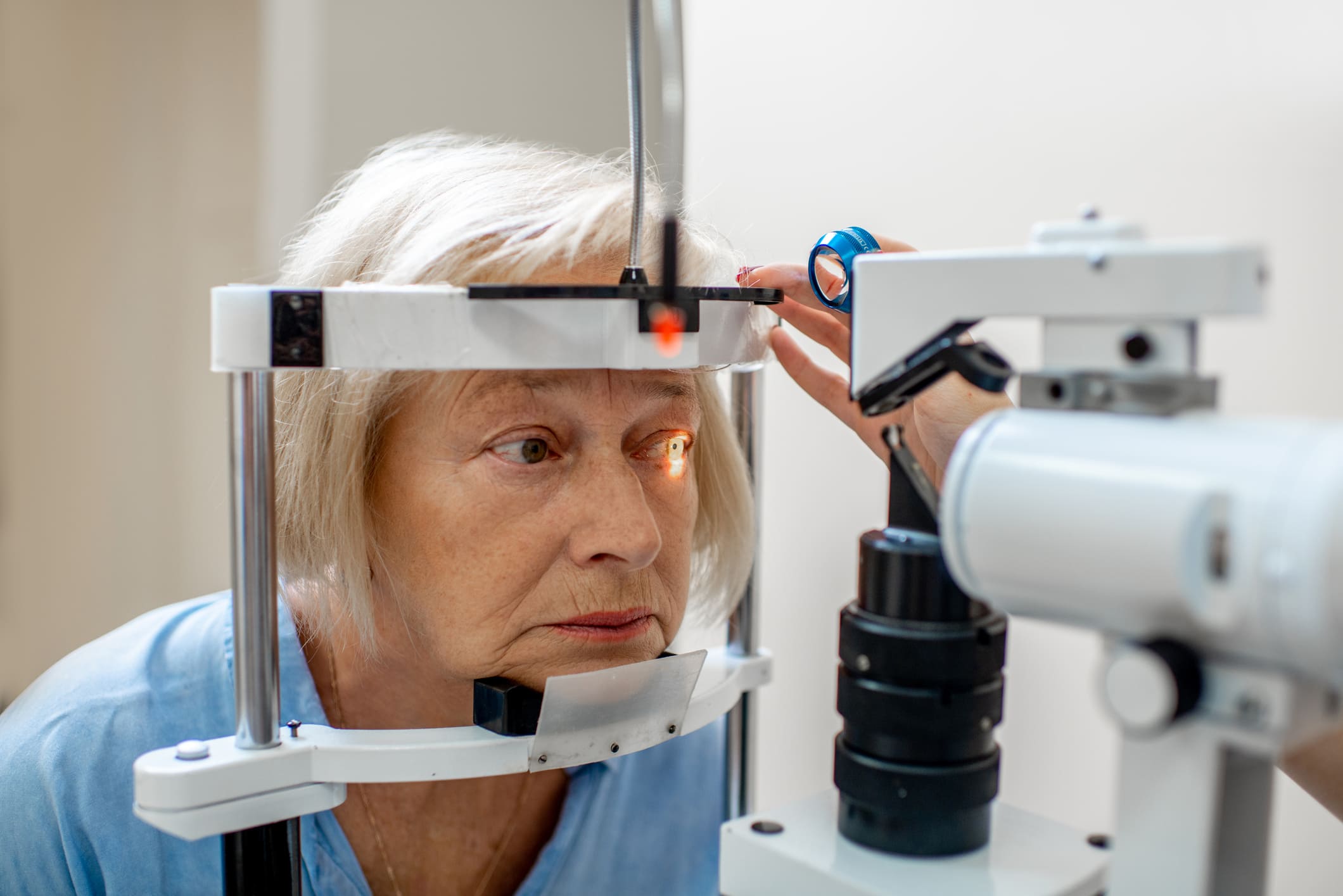The factors leading to AMD go beyond age and the more you know, the more you can understand, control and manage your risk.
How aging and other risk factors affect your vision
As the name suggests, age-related macular degeneration (AMD) is largely caused by aging. The disease happens when aging causes damage to the macula, which is the part of the retina that controls sharp, straight-ahead vision.[1]
However, while aging is a major cause, there are several risk factors that increase the likelihood of developing AMD. Knowing these risk factors can help people to lower their risk, prevent or delay the onset of the disease. As AMD is the leading cause of vision loss in people age 50 and older,[2] being well informed can make a huge difference in quality of life.

Breaking down AMD: Forms, effects, and risk factors
“AMD is a breakdown at the cellular level of the central part of your eye, the macula,” says Dr. Trevor Miranda, an optometrist and owner of Cowichan Eyecare in B.C. “It’s a slow damaging process that can devastate your vision over time. It’s like losing pixels in a TV screen – at first you can still see the image but over time the image becomes distorted as you lose more and more pixels.”
This vision impairment can affect patients quite drastically. “The macula is the most important part of your vision because it gives you detailed vision and colour vision,” says Dr. Miranda. “It’s the part of your eye that you see faces with.”
AMD can present in two different forms: dry and wet.[1] “Dry AMD is the accumulation of drusen,[2] which are usually like a cholesterol lipofuscin exudate from the cell,”[3] explains Dr. Miranda. “This can damage the photoreceptors and cells in the macula, sometimes to a devastating effect, especially if the dry AMD progresses to something called geographic atrophy,[4] which is a subset of dry AMD.”
Typically, however, the dry forms of AMD are milder, whereas wet AMD leads to more severe vision loss.[5] “In wet AMD, fluid leaks between and under the retina,” says Dr. Miranda. “You get damage at the cellular level and the body responds to the leaking fluid by scarring, which devastates the vision.”[6]
For adults hoping to prevent or delay the onset of AMD, knowledge is power. “Cellular death occurs in aging, so a lot of the eye diseases, including AMD, are a result of aging,” says Dr. Miranda. “But that’s only one of the factors. Other things play a role: genetics, ethnicity, gender, nutrition, lifestyle factors like smoking and lack of exercise, UV exposure and more.”

Dr. Miranda separates AMD risk factors into two categories: non-modifiable and modifiable. Non-modifiable risk factors cannot be changed, and they include age, genetic predisposition, ethnicity, gender and eye colour. “Genetics is the biggest one,” says Dr. Miranda. “If you have a family history of AMD, your risk is greatly increased.”[1],[2]
Ethnicity is a risk factor as a U.S.-based study showed the disease was more prevalent in Caucasians, followed by Chinese and Hispanics, with the lowest risk in African-Americans.[3] This may be connected to another risk factor: eye colour. Studies have found that AMD is more prevalent in people with light-coloured eyes.[4] Some studies also suggest that it’s more prevalent in women than in men.[5]
Protecting your vision: Lifestyle changes and early detection for AMD prevention
Modifiable risk factors include nutrition, smoking,[1] UV exposure[2] and cardiovascular health.[3] Modifiable risk factors can be changed, empowering people to take their health into their own hands. Dr. Miranda emphasizes the importance of a healthy lifestyle in reducing AMD risk. “Nutrition is a big one,” he says. “You want to reduce the inflammatory toxic effects of things like processed foods and nitrates. Comorbidities such as obesity, heart disease, high blood pressure and high cholesterol can also be risk factors leading to increased odds of developing AMD.[4]” Diabetes is a big risk factor too,[5] notes Dr. Miranda.
Dr. Miranda recommends eating a whole foods diet, stopping smoking, exercising regularly and protecting the eyes by wearing sunglasses with UVA/UVB protection outdoors.
“And get your eyes tested regularly,” he adds. With early detection, AMD can be better managed and treated.
Don’t let age-related macular degeneration (AMD) impact your quality of life. By understanding the risk factors—both modifiable and non-modifiable—you can take proactive steps to protect your vision. From improving nutrition and quitting smoking to wearing UV-protective sunglasses, small lifestyle changes can make a big difference.
MacuMira Vision Therapy offers a non-invasive, effective, and comfortable solution to help manage AMD and support better vision health. Schedule an eye exam today and consult with your optometrist about how MacuMira Vision Therapy can help prevent progression and improve your eye health.
If you have questions about AMD or want to learn more about MacuMira Vision Therapy, contact us today for expert guidance and support!
Disclaimer: Always speak to your primary health care provider and/or eye care provider before making any changes to your lifestyle, activities or diet.
References
-
- https://www.nei.nih.gov/learn-about-eye-health/eye-conditions-and-diseases/age-related-macular-degeneration
- https://www.aao.org/eye-health/diseases/amd-macular-degeneration
- https://www.aao.org/eye-health/diseases/amd-macular-degeneration#types
- https://www.sciencedirect.com/topics/neuroscience/lipofuscin
- https://www.aao.org/eye-health/tips-prevention/syfovre-izervay-geographic-atrophy-amd-macular-deg
- https://www.aao.org/eye-health/tips-prevention/six-things-about-amd
- https://pubmed.ncbi.nlm.nih.gov/21865200/
- https://www.ncbi.nlm.nih.gov/pmc/articles/PMC4877264/
- https://www.ncbi.nlm.nih.gov/pmc/articles/PMC1298217/
- https://www.aao.org/eye-health/ask-ophthalmologist-q/macular-degeneration-women
- https://www.macularsociety.org/support/daily-life/practical-guides/healthy-living/smoking
- https://pubmed.ncbi.nlm.nih.gov/26441265/
- https://www.ncbi.nlm.nih.gov/pmc/articles/PMC7956087
- https://www.cos-sco.ca/amd-awareness-month-sheds-light-on-the-leading-cause-of-severe-vision-loss-in-older-adults/
- https://www.ncbi.nlm.nih.gov/pmc/articles/PMC4169602/




